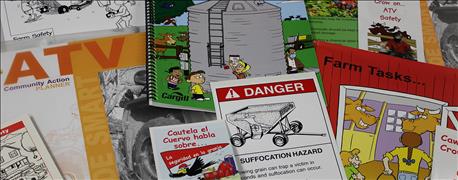June 11, 2016

Summertime is when farm kids and their friends are most likely to be working or “hanging around” outdoor activities on the farm. That’s when accidents are most likely to happen. These actual headlines from across the country tell of deadly farm stories no one wants to happen:
1. “11-year-old crushed by 1,100-pound bale”
2. “1-year-old struck by skid loader”
3. 3-year-old run over by tractor”
4. “15-year-old drowned when skid loader fell into manure pit”
5. “Toppled fork lift crushes 2-year-old”
6. And the latest in early July from Georgetown, Mass.: “Family devastated after cow tramples 8-year-old.” It only takes a second for a terrible life-changing moment to happen.
Every three days, a child dies in an ag-related incident in the United States. Each day, 33 children are injured. Those are the latest grim numbers from the 2016 Childhood Agricultural Injuries Fact Sheet compiled by the National Children’s Center for Rural and Agricultural Health and Safety. The leading sources of fatalities are machinery (25%), motor vehicles/ATVs (17%) and drowning (16%), adds Scott Heiberger, spokesman for the center at Marshfield, Wis.
In Pennsylvania alone, more than 12 people lost their lives in incidents involving skid steer or forklift use or repair; another 26 during bush hogging activities from 2005 through 2015, notes Dennis Murphy, farm safety ag engineer at Penn State University.
Skid steers and forklifts have more maneuverability, they can work in smaller spaces. Many of the fatalities are the result of a child or on-the-ground helper being run over. Collapsing buckets or lift arms during repair or maintenance have led to deaths as well.
High risk areas
Here’s where the risks are highest:
* Among farm youths, injury rates increased in the 10 to 19 age group, despite a continued decline in the rate of ag-related injuries of younger children, reports Heiberger.
* While overall numbers of farm injuries are declining, injuries to farm youth have held steady.
* Among workers younger than 16 years, ag worker fatality numbers are consistently higher than in all non-agricultural industries combined.
* Vehicles remain the leading source of injury for working farm youth.
* Animals are still the leading source of injury for both non-working farm youths and visitors.
Up your farm safety awareness
Bone up on safety guidelines for children living or working on farms. That’s what the North American Guidelines for Children’s Agricultural Tasks at www.nagcat.org/nagcat/ is all about.
NAGCAT is designed to assist parents and others in assigning age-appropriate tasks for children ages 7 to 16. They’re based on an understanding of childhood growth and development, agricultural practices, principles of childhood injury and ag safety risks.
Training teenagers to be farm safety-savvy can be especially challenging. There are concrete measures you can take to integrate safety into agritourism, teach ATV and tractor safety, create safe play areas on the farm, and safety-train hired youths. You can find educational resources for them all under the “Prevention” tab at marshfield clinic research.
Another site worth visiting is Farm Safety For Just Kids. Don’t let the title fool you. Its fact sheets are for all ages of kids. Go to: farmsafetyforjustkids.
And learn about what you can do to reduce farm-related child and youth injuries and deaths at this Penn State website: ag-safety/youth-safety .
Most farm shows and field days coming up this summer and fall also will have farm safety exhibits and take-home information. Seek them out and check them out with your children and/or grandchildren. While you’re there, discover why farmers over age 60 suffer the highest farm fatality rate.
You May Also Like




